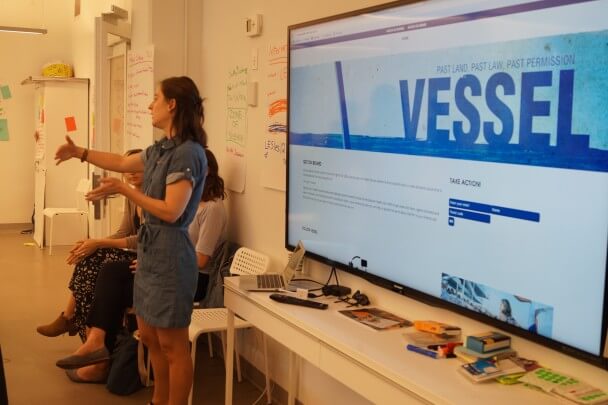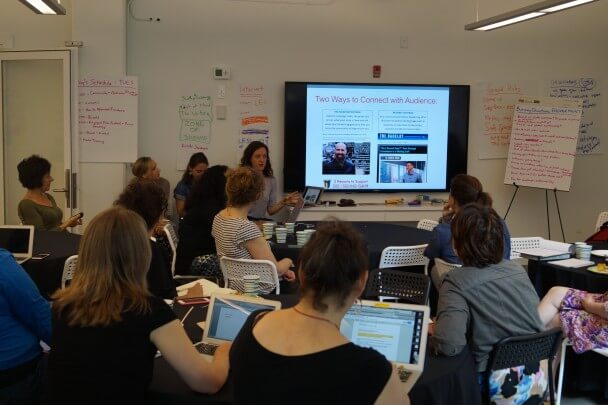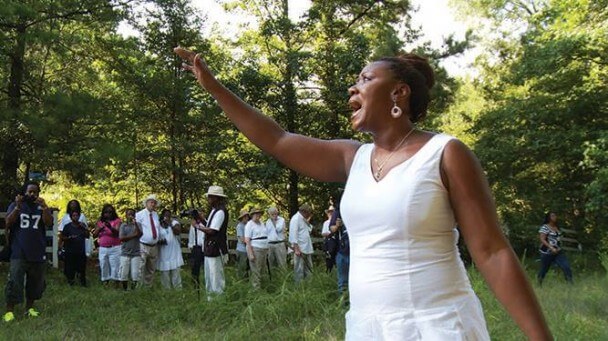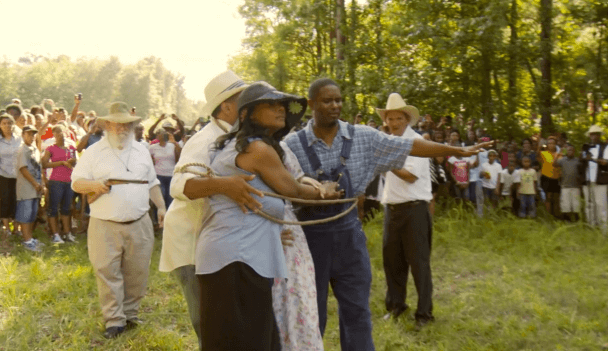Mentorship Selects: 7 tips for pitching your film
With the help and guidance of our guest experts and industry friends, we’ve put together this list of our 7 tips to keep in mind when you are pitching your film or project.
Practice, practice, practice.
Pitching is like a performance. If you’re prepared, you will feel and appear more relaxed.
Don’t repeat everything that is in your trailer.
Use every opportunity to share new information about your project.
Accept the feedback and any criticism you get.
Don’t waste time trying to argue; say thank you and hold back defensiveness.
Match your presentation to the tone of your film.
If it is a serious topic, reflect that in your voice. If it if it is light match that.
Let the images speak for themselves.
Explain the compelling story, not the style. It’s hard to explain style and tone.
Do your research.
Know who you are speaking with and familiarize yourself with their interests and passion issues. Take notes so that when they follow up with you, you can show growth.
Know the landscape.
If you pitch something that sounds like something a distributer has already done, immediately distinguish it. Be humble; don’t say “my film is better;” say that your film “builds on these others because…”
Mentorship Selects: Community screenings as a tool for engagement and impact
Caitlin Boyle of Film Sprout joined us to talk about how she sees community screenings as a vehicle for social change. She used her work on Diana Whitten’s film Vessel, a Chicken & Egg Pictures grantee and member of our Reel Reproductive Justice cohort, as a case study of how screenings can activate communities on an issue; in this case, abortion access.

Here are her strategies for using community screenings to create engagement around your film:
The filmmaker and partners should set goals for what each screening should accomplish.
In some places, Vessel screenings collected ticket fees to fund abortion access, while in areas with limited or no abortion access, bringing the film for free was paramount.
Use the calendar to give the campaign an arc.
For the Vessel screenings, Caitlin utilized the Roe v. Wade anniversary and International Women’s Day to plan special events and incentivise screenings during those days.
Align metaphors in movie with engagement campaign.
For the Vessel screenings, the engagement campaign used metaphors like “going into uncharted waters” to market the events.
Think outside the fee.
Not every group can pay screening fees but you can barter free screenings for translations into other languages and retitling or subtitles, which will help the film reach more places.
Make sure engagement happens offline as well as online.
There was a large audience for Vessel in pro-choice 60-80 year olds who might not be on facebook or using email. Use digital platforms, but remember to make calls to reach your audience.
Survey screening hosts to get feedback, metrics and understand impact.
Send your survey a few weeks after and keep it short, about 15 questions.
Mentorship Selects: Are you my audience? Connecting your film with new communities
Sara Kiener, co-founder of Film Presence and audience engagement expert, begins her outreach campaigns with one essential question: Why are you making this film?
Once you can identify the reasons you are making the film and why it matters, she says, you can can find your audience from there.

Here are her suggestions for creatively connecting with new audiences:
Don’t limit yourself to two or three audience groups, when you could go after twenty.
It’s not always easy to predict which groups will be interested in the film, so it’s best to cast a wide net when reaching out to partners. For example, while working on the outreach campaign for Do I Sound Gay?, she connected with anti-bullying organizations, fans of David Sedaris and Dan Savage (both men are featured in the film), This American Life listeners who are familiar with Sedaris from the radio program, and speech therapists interested in the topic of voice, and many more organizations and individuals who could link the film to new audiences.
When you first reach out, don’t ask for money right away.
Start with building a relationship and see how they might be able to help you. An organization might be interested in sharing your posts on social media or sending information about your film around in their circles.
Get personal on social media!
Show pictures from the process of your film being made. Put a quote on top of a picture to make an easy to share post about your film. Ask celebrities who care about the issues in your film to share posts or pictures of themselves in connection to the film.

Filmmaker Dispatch: Jacqueline Olive, director of Always in Season
I’m directing and producing ALWAYS IN SEASON, a documentary that examines the lingering impact of almost a century of lynching African Americans and follows relatives of the perpetrators and victims in three communities who are seeking justice and reconciliation.
The project is particularly relevant in the wake of the grand jury decision not to indict the Staten Island police officer who killed Eric Garner. The turmoil the country now faces after repeated incidents of racial violence gone essentially unchecked powerfully demonstrates the unfinished business of confronting lynching. My goal is that Always in Season will move viewers to begin dialogues in their communities about not only ways to address the historical racial violence of lynching, but also strategies for stopping the killing of unarmed people of color by police and vigilantes that is occurring in numbers comparable to the rate of lynchings per week, at its height, across the country.
The emotional intensity of the subject matter is definitely challenging. When I first began to look at the collection of photographs of men, women and children posing with the tortured bodies of lynching victims, it was deeply troubling. But, if I’d refused to look closer, I wouldn’t have learned who the people were in those scenes. Just as importantly, I’ve gotten to know inspiring people who are featured in the film, like Olivia Taylor, who witnessed a lynching at the age of 3, and is part of a multiracial group of amateur actors who reenact the 1946 lynching of two couples annually in Monroe, GA, (outside of Atlanta) on the very spot where the violence happened. And, Rev. David Kennedy, who has spent almost two decades fighting to close the shop that sells KKK robes and neo-Nazi memorabilia right in the middle of downtown Laurens, SC, and less than a mile from where his great-uncle was lynched in 1913. In Duluth, MN, three men were lynched in 1920 with two thousand spectators watching. The film goes there to follow Don Clariette, a cousin of one of the victims, along with Warren Read and Mike Tusken, relatives of some of the perpetrators, as they attempt reconciliation after the first-ever memorial to lynching victims was erected. These stories, of descendants and others taking action to acknowledge the victims, repair the damage, and reconcile, light a path towards healing.
It also doesn’t get any more motivating than the support I’ve received from Chicken & Egg Pictures. We finished principal filming and have begun fundraising to create a rough cut. In the earliest days of production, shortly after using up my own funds to shoot test interviews, Chicken & Egg awarded us an I Believe in You Grant. The name says it all! Not only did they provide funding at exactly the right time to make it possible for us to film, but Chicken & Egg also continues to support the project, most recently granting funds for editing earlier this year. Mentorship workshops, like the one I attended last spring and co-sponsored by another valuable project funder, Catapult Film Fund, are just as important and have prepared me for the editing that lies ahead with critical feedback on character development and structure from fellow filmmakers. In fact, my editor, Michaelle Stikitch, and I used notes from that workshop to revise the work-in-progress by June, and that cut of the film screened at the Cucalorus Festival last month.
Cucalorus was outstanding! The festival gave the project exposure and the team more input as the film screened several times at different venues during the week to audiences of students and educators, community organizers, filmmakers, and more. The experience showed me that Always in Season resonates with a broad audience eager to see the film completed.
If you would like more information on the Always in Season project, or if you would like to support the project, visit www.alwaysinseason.net.
Chicken & Egg Pictures Kicks Off Fall Mentorship with Distribution Day
When I got the call in 2011 that I was being awarded a Chicken & Egg Pictures “I Believe in You” grant for my documentary Home Again, I was thrilled. The money and the prestige were awesome rewards, but possibly the most meaningful benefit of the grant was being welcomed into the Chicken & Egg nest.
It was truly inspiring on Wednesday to gather with fellow grantees for Distribution Day, where we convened with Cynthia Kane of Al Jazeera America, Nina Chaudry, Former Executive Producer of Wide Angle, and Susan Margolin of Cinedigm. Though my film is not yet finished, it’s never too early to think about distribution, as nearly every presenter pointed out. As we discussed possible outlets for our projects and how to imagine different versions of the stories we want to tell, the wheels in my head began to turn about the many different directions my film could go in.
In our discussion of what (and what not) to cut when reversioning, one rule that went up on the easel pad was “Time spent laughing is never wasted time.” And time spent brainstorming with other fantastic women, I’ve found, is one of the most productive things a filmmaker can do.


